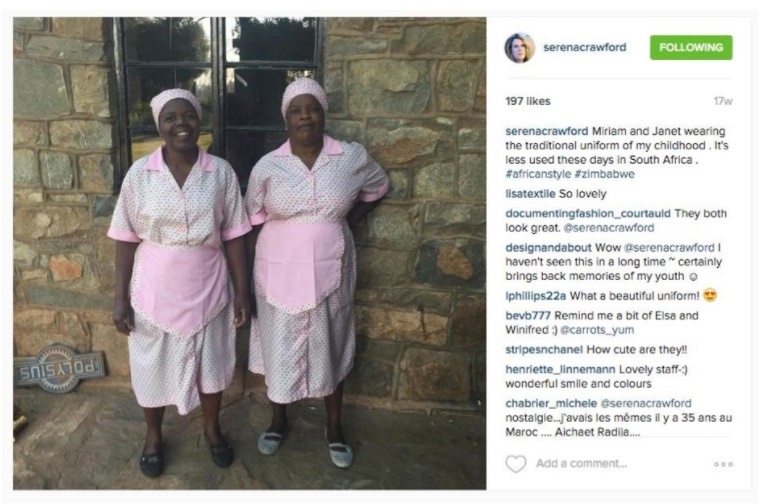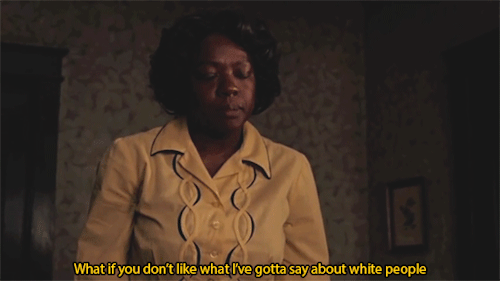
Growing up, we always had a domestic worker. Many of my friends had live-in domestic workers, who cooked and cleaned and were at the beck and call of their employers.
They raised the children to an extent; teaching Afrikaans kids some isiXhosa. And there are many stories where children end up referring, exclusively and lovingly, to their Zulu domestic ‘mother’ as ugogo.
But what always stuck with me was the uniform and the way it seemingly separated her from the family. So intensely involved, yet still not part of the unit.
READ MORE: A gardener asks for a VAT increase and is called "opportunistic"
It has long been the topic of controversy - remember when in 2014, white University of Pretoria students dressed up as domestic workers and sported blackface?
And how can we forget Serena Crawford-gate and her nostalgic colonial captions on her Instagram account, longing for the ‘good old’ days where all domestics still wore their neat pakkies. (When serving her tea, no doubt.)
Image: Screengrab via DailyVox
The uniform as an indicator of status
In an article by Allison Happel on Ritualized girling: school uniforms and the compulsory performance of gender, the school uniform makes it almost compulsory for ‘girls to girl’. You wear the uniform, and it then acts as your costume for performing as a girl. The kind of girl the school demands, maybe one that is feminine, well-behaved, etc.
And with so many uniforms come stigmas or status, think for example about the way the U.S. has glorified their military uniform, almost to the level of god-like proportion (depending on your political leanings of course). Pilots, even doctors' scrubs, are all uniforms with high status attached because of the way they have been historically valued. Desirable job, desirable uniform.
The South African domestic worker uniform is basic, yet it stands out to anyone who grew up within our borders. It is not just to protect the workers clothing against dirt and staining. It is a symbol of exclusion. By wearing it, the power relationship becomes clear. The maid/madam, master/servant, predominantly black/white, underprivileged/privileged roles are clearly segregated. By wearing the uniform, the worker is immediately defined by its parameters.
Some tweets pertaining to the EFF wearing domestic worker uniforms inside parliament show the hierarchical value this uniform has for South Africans:
As long u r seen in a domestic worker's uniform, u r bound 2 b abused. Ask the EFF EFF EFF in parliament with the uniform, bouncers r called https://t.co/JhHb9OkMzR
— Afrocentric Lecturer (@Tshishongetd) August 20, 2017
And they called Lindiwe Zulu a cleaner as an insult while they were wearing domestic worker's uniform in parliament. They're confused those ones. https://t.co/xakpwlcaB2
— Tshidi. (@tshidi_lengoasa) April 9, 2018
Wearing domestic worker's uniform and get huge salary at the end of the month is a insult to our mothers who wear this uniform with broken hearts....
— Victor Manyonya (@MManyonya) January 23, 2018
Academic Shireen Ally knows well the space in South Africa concerning servitude and its connected relationships, noting in particular the individual struggles and histories of women who work in (often informal) domestic employment in her work. Many of these women come from outside South African borders and end up as poorly paid domestic workers, often at the mercy of their all-powerful employers who make all the rules. (All-powerful, because it’s such an unregulated field to a large extent.)
And, as discussed at length by Nomsa C Ngqakayi in Subjectivity in the 'Maid/'Madam' relationship and its effects on the occupational child care-giving functions of the domestic worker, clothes are an indicator of status. The domestic worker usually wears a uniform while the employer wears civilian clothes, automatically cementing hierarchy.
The same is noted in a study by Ena Jansen, From Thandi the Maid to Thandi the Madam: Domestic Workers in the Archives of Afrikaans Literature and a Family Photograph Album, where the central preoccupation is with the conflict of its presence/absence in the tense and intense relations of intimacy and distance in domestic service. It's never equal.
A great example she gives is the one where historically in South Africa, black kitchen workers were given different names by their white employers, who found it hard to pronounce their Xhosa names. The study notes that later parents started giving their children names like Beauty or Patience in order for them to have success in the future in white working environments.
The domestic worker and their family are the ones who always had to adapt to the wants and needs of the predominantly white employers. Therefore, the relationship, whether tense or intense is only up to the employer. They predict or choose and manage the extent of closeness to the family the worker is allowed.
Like in The Help, a film about a white journalist clandestinely interviewing black domestic workers in the notoriously bigoted Mississippi South, the 'maids' are forbidden to use the toilet inside the house. The one used by the white families they work for.
Image: Giphy
In his Masters thesis, “For better or worse”: Domestic work and outsourced housecleaning services in Stellenbosch, UJ lecturer David Du Toit discussed, among other things, the nature of the master-servant relationship - particularly when it comes to domestic workers in South Africa.
“Domestic servants were neither part of the masters’ families, nor complete outsiders. On the one hand, they had to be considerate to the changing moods of masters and serve them unconditionally, on the other, their presence was frequently unnoticed and ignored (Gill, 1990: 128). This distance and difference [was] enhanced by the obligation of domestic servants to wear uniforms and to use different cutlery and crockery. Hansen (1989: 67) reports how male domestic servants in Zambia were not permitted to wear shoes while working in the houses of masters, to sit on sofas, to listen to the radio, to read newspapers, or to use toilets of masters. Difference and distance are also enhanced by the use of language to evoke inferiority and subordination. For example, Gill (1989: 129) reports how masters in Bolivia required domestic servants to call them “señora”, while domestic servants are addressed by their first names.”
It’s not just about protecting clothes
Ngqakayi found that many black families within her study didn’t require their domestics to wear uniforms. The study notes “'madams' in the black households did not attach much importance to uniform. The domestic worker in Household 4 said "I wear my own clothes at work. It does not make any difference to me whether I wear one or not." Her 'madam' had this to say, "I've never given that much thought ... as it does not determine the way she works."
Domestics brought up the issue of acceptance. Not being required to wear a uniform made them feel part of the family. “Her 'madam' seemed to partly link a uniform with a demarcation of employer and employee, which she did not think was necessary. Moreover, the domestic worker was not doing "dirty" work which would require the wearing of a uniform.”
READ MORE: Why South African women should down tools in October every year
The ‘madam’ also recognised the demarcation it can cause, saying “I don't think that wearing a uniform is necessary because there is no reason to have other people notice that she works here”.
On the other hand, the study found that in the select few white households that were interviewed, the wearing of a uniform by the domestic worker is standard practice. One ‘madam’ saying, “…she was very happy with a uniform, she loved it. And I think it's nice because it saves their clothes. [DWY] put on her uniform on the first day even before I mentioned anything about uniforms. Personally, I hate uniforms. I hate looking like everybody else. But yes, if I had a domestic worker who said to me I don't want to wear a uniform, I wouldn't accept it, because you don't have to put on a different dress every day, you'd just wear your uniform.”
This is just what one study of households revealed.
Another study by Sarah Archer conducted in Cape Town, ‘Buying the Maid Ricoffy’: Domestic Workers, Employers and Food sums it all up for me: “the rules governing domestic workers' access to food” is pointed out as an indicator of power play. While power relationships have shifted since apartheid, it is still a practice in many households where “employers use covert codes and norms to maintain a skewed power structure”, sometimes without probably doing so maliciously.
This particular uniform is a historical practice/symbol of power play, power imbalance between black and white and ultimately a blindspot for many who cannot see past the opressive structures that still sees some move and operate effortlessly, while others are restricted in their survival.
Sign up to W24’s newsletters so you don't miss out on any of our hot stories and giveaways.
Disclaimer: The views of columnists published on W24 are their own and therefore do not necessarily represent the views of W24.




 Publications
Publications
 Partners
Partners
















